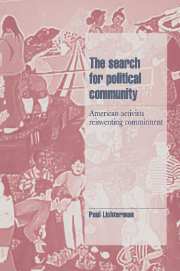Book contents
- Frontmatter
- Contents
- Acknowledgments
- 1 Personalism and political commitment
- 2 Personalized politics: the case of the US Greens
- 3 Speaking out in suburbia
- 4 Imagining community, organizing community
- 5 Culture, class, and life-ways of activism
- 6 Personalized politics and cultural radicalism since the 1960s
- 7 The search for political community
- Appendix I Choosing and studying the organizations
- Appendix II Why participant-observation was necessary
- Notes
- References
- Index
5 - Culture, class, and life-ways of activism
Published online by Cambridge University Press: 23 January 2010
- Frontmatter
- Contents
- Acknowledgments
- 1 Personalism and political commitment
- 2 Personalized politics: the case of the US Greens
- 3 Speaking out in suburbia
- 4 Imagining community, organizing community
- 5 Culture, class, and life-ways of activism
- 6 Personalized politics and cultural radicalism since the 1960s
- 7 The search for political community
- Appendix I Choosing and studying the organizations
- Appendix II Why participant-observation was necessary
- Notes
- References
- Index
Summary
A SOCIAL CONTEXT FOR PERSONALIZED POLITICS
Even though Greens could not rally around communal traditions the way HAT members could, they still wanted to live publicly responsible lives. And they shared assumptions on how to go about it. When Carl and Linda argued about what the Ridge Greens should be doing, neither questioned that good activism meant individualized, self-empowered activism. Why were Greens able to take this assumption for granted? Not all people can or want to make such personalized commitments. The personalized style is a cultural response to a lack of shared, traditional cultural authority of the sort HAT could invoke. But most people do not feel comfortable speaking out as individuals. Most people do not develop their own elaborate, individual political ideologies at length, at least not without explicit guidance from a leader like Ben Norton of HAT or Laura of ACES. Why did Greens assume it possible to build an organization out of personalized political wills, instead of just living out their visions, each on her own? And why did they continue carrying individualized commitments even when organizations like the Ridge Greens endured such difficulties?
We can answer these questions by understanding how activists' socioeconomic backgrounds and the broader institutional arenas for activism shape their opportunities for commitment. This chapter and the next treat these two contexts for commitment. This chapter focuses on the class-linked culture that makes personalized politics possible to begin with. Activists' class backgrounds did not cause their activism, nor did they cause activists to follow one commitment style rather than another.
- Type
- Chapter
- Information
- The Search for Political CommunityAmerican Activists Reinventing Commitment, pp. 146 - 181Publisher: Cambridge University PressPrint publication year: 1996



